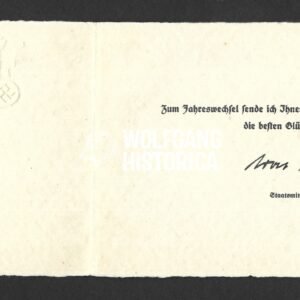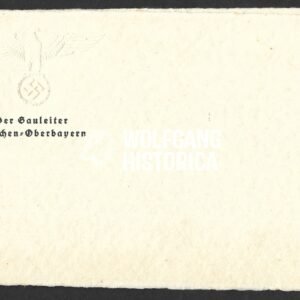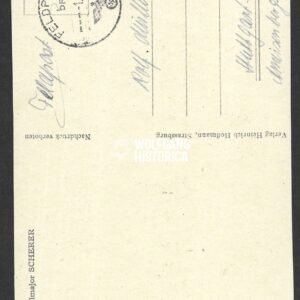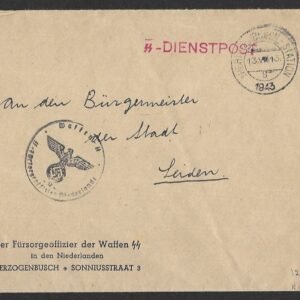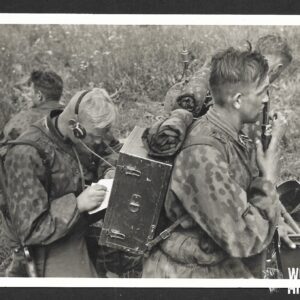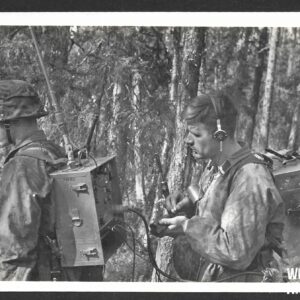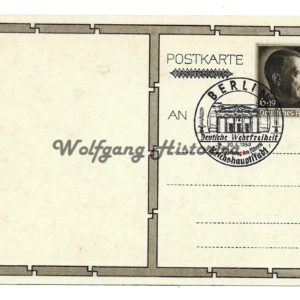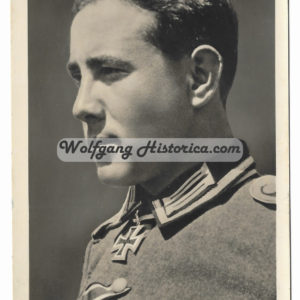Customers facing issues ordering, contact me
via info@wolfganghistorica.com or wolfganghistorica@gmail.com
NEW HOUTEN MILITARIA FAIR VIDEO ONLINE: Watch it here!
Wartime Signed New Year’s Greeting Card Signed by Gauleiter and Staatsminister Adolf Wagner
€395,00Original folding New Year’s greeting card from Adolf Wagner (1 October 1890 – 12 April 1944), Gauleiter of Munich–Upper Bavaria (München–Oberbayern) and Bavarian State Minister (Staatsminister). Wagner was one of the early members of the NSDAP and a senior political leader in Bavaria, holding the dual posts of Gauleiter and Minister of the Interior until his death in 1944.
The card bears the printed message:
“Zum Jahreswechsel sende ich Ihnen auch im Namen meiner Frau die besten Glückwünsche” (“At the turn of the year, I send you, also in the name of my wife, my best wishes”).
Signed in ink “Adolf Wagner” below the printed title Staatsminister. The cover shows the embossed eagle and swastika emblem above the printed letterhead Der Gauleiter München–Oberbayern.
Item Details
-
Original wartime New Year’s greeting card from Gauleiter and Staatsminister Adolf Wagner.
-
Signed in ink on the interior.
-
Embossed party eagle and printed heading on the front panel.
-
Format: Folding card, approx. 10 × 15 cm when closed.
-
Condition: Excellent; minimal age toning and handling wear. Signature remains bold and well preserved.
Collector’s Note
A fine and authentic example of official correspondence from Adolf Wagner, one of the highest-ranking regional leaders of the NSDAP and a key political figure in Bavaria. Such personally signed seasonal greeting cards were distributed to selected officials and associates, and examples with intact embossing and clear signatures are scarce and historically valuable.
Eduard Dietl – 3.Geb.Div., Gebirgs-Korps Norwegen & 20. Gebirgsarmee (Schwertern) (Wartime Signed)
€155,00Original Wartime Signature on a Postcard of Generaloberst Eduard Dietl (21 July 1890 † 23 June 1944) was one of the most renowned commanders of the German mountain troops (Gebirgstruppe) during the Second World War. Rising from Generalleutnant to Generaloberst, he led German forces in Norway and later commanded the 20. Gebirgsarmee in the far north. He was among the earliest recipients of the Ritterkreuz des Eisernen Kreuzes and one of the very few to be awarded the Eichenlaub and Schwertern.
Awards and Decorations
-
Knight’s Cross of the Iron Cross – 9 May 1940, as Generalleutnant und Kommandeur of 3. Gebirgs-Division.
-
Oak Leaves (Eichenlaub) – 19 July 1940, as Generalleutnant und Kommandierender General of Gebirgs-Korps Norwegen.
-
Swords (Schwertern) – 1 July 1944, as Generaloberst und Oberbefehlshaber of 20. Gebirgsarmee.
-
Additional awards: Iron Cross (1914) 1st and 2nd Class, Clasp to the Iron Cross (1939), and numerous foreign and campaign decorations.
Item Details
-
Original wartime signature of Generaloberst Eduard Dietl.
-
Signed on a wartime postcard.
-
Condition: As seen – period ink signature, postcard stock consistent with the era.
Death
On 23 June 1944, the Ju 52 transport aircraft carrying Dietl crashed near Rettenegg, Styria, killing him along with General der Infanterie Thomas-Emil von Wickede, General der Gebirgstruppe Karl Eglseer, Generalleutnant Franz Rossi, and three others. There were no survivors.
Collector’s Note
Eduard Dietl remains one of the most iconic figures of the Gebirgstruppe and among the most decorated German commanders of WWII. His status as a Ritterkreuz mit Eichenlaub und Schwertern recipient, combined with his high command role and tragic death in 1944, makes his original wartime autograph a highly desirable and rare collectible.
Theodor Scherer – 281. Sicherungs-Division (Eichenlaub) (Wartime Signed)
€150,00Original Wartime Signature on a Postcard of Generalleutnant Theodor Scherer (17 July 1889 † 11 May 1951) was a German Army officer best known for his leadership during the Demyansk Pocket battles in 1942. As commander of the 281. Sicherungs-Division, Scherer’s determined defense against Soviet forces earned him both the Ritterkreuz des Eisernen Kreuzes and later the Eichenlaub to the Knight’s Cross.
Awards and Decorations
-
Knight’s Cross of the Iron Cross – 20 February 1942, as Generalmajor und Kommandeur of 281. Sicherungs-Division.
-
Oak Leaves (Eichenlaub) – 5 August 1942, as Generalleutnant und Kommandeur of 281. Sicherungs-Division.
-
Iron Cross (1914) 1st and 2nd Class.
-
Clasp to the Iron Cross (1939) 1st and 2nd Class.
-
Additional Wehrmacht and long service awards.
Item Details
-
Original wartime signature of Generalleutnant Theodor Scherer.
-
Signed on a wartime postcard.
Collector’s Note
Theodor Scherer is remembered as the “Hero of Demyansk” for his role in the encirclement battles on the Eastern Front. His autograph is scarce and highly collectible, particularly on wartime material, as he received both the Knight’s Cross and Oak Leaves within the same year of heavy combat.
Hugo Primozic – Sturmgeschütz-Abteilung 667 (Eichenlaub) (Wartime Signature)
€100,00Original Wartime Signature on a Wartime Postcard of Hugo Primozic. Oberleutnant Hugo Primozic (16 February 1914 – 18 March 1996) was one of the most successful Sturmgeschütz (assault gun) commanders of the Second World War. Serving with Sturmgeschütz-Abteilung 667, he achieved remarkable success against Soviet armor, earning both the Knight’s Cross of the Iron Cross and the Oak Leaves within a span of just a few months in late 1942 and early 1943. His extraordinary tally of destroyed enemy tanks made him one of the legendary figures of the German assault gun arm.
Awards and Decorations
-
Knight’s Cross of the Iron Cross (Ritterkreuz des Eisernen Kreuzes) – 19 September 1942, as Wachtmeister and Zugführer, 2./Sturmgeschütz-Abteilung 667.
-
Awarded for destroying 45 enemy tanks during fighting in the central sector of the Eastern Front. Of these, Primozic destroyed 24 in one day (15 September 1942), halting a major Soviet breakthrough.
-
-
Oak Leaves to the Knight’s Cross (Ritterkreuz mit Eichenlaub) – 25 January 1943, as Oberwachtmeister and Zugführer, 2./Sturmgeschütz-Abteilung 667.
-
Awarded for raising his total of destroyed tanks to 60. On 11 December 1942 alone, he destroyed 7 Soviet tanks during a counterattack.
-
Career Highlights
-
Zugführer (platoon leader) in 2./Sturmgeschütz-Abteilung 667, operating on the Eastern Front.
-
September 1942: Destroyed 24 tanks in a single day, preventing a Soviet breakthrough – a feat that earned him the Ritterkreuz.
-
December 1942: In another display of skill and tenacity, destroyed 7 tanks in one day, bringing his tally to 60 and earning him the Eichenlaub.
-
Rose to the rank of Oberleutnant before the war’s end.
-
Survived the conflict and lived until 1996.
Item Details
-
Authentic wartime signature of Hugo Primozic.
-
Signed on a wartime postcard.
-
Condition: Good, clear and well-preserved.
Collector’s Note
Hugo Primozic stands among the most celebrated Sturmgeschütz aces of the German Army. His tank-destroying record – especially the extraordinary achievement of 24 tanks in a single day – has become legendary. His autograph, particularly on a wartime postcard, is a prized piece for collectors of Panzerjäger history, Ritterkreuz recipients, and Eastern Front memorabilia.
Horst Niemack – Aufklärungs-Abt. 5 & Panzer-Füsilier-Rgt. “Großdeutschland” (Schwertern) (Wartime Signed)
€145,00Awards and Decorations
-
Knight’s Cross of the Iron Cross – 14 July 1940, as Rittmeister und Kommandeur of Aufklärungs-Abteilung 5.
-
Oak Leaves (Eichenlaub) – 10 August 1941, as Rittmeister und Kommandeur of Aufklärungs-Abteilung 5, 5. Infanterie-Division.
-
Swords (Schwertern) – 4 June 1944, as Oberst und Kommandeur of Panzer-Füsilier-Regiment “Großdeutschland,” Panzer-Grenadier-Division “Großdeutschland”.
-
Iron Cross (1939) 1st and 2nd Class, German Cross in Gold, and other Wehrmacht service and campaign decorations.
Item Details
-
Original wartime signature of Generalmajor Horst Niemack.
-
Signed on a wartime postcard.
-
Condition: As seen – period ink autograph on postcard stock.
Collector’s Note
Horst Niemack was one of the most prominent commanders of the Großdeutschland Division, leading elite infantry and armored formations in some of the fiercest fighting on the Eastern Front. His status as a Knight’s Cross with Oak Leaves and Swords recipient makes his autograph especially desirable for advanced collectors of Heer and Großdeutschland memorabilia.
Nikolaus von Falkenkorst – XXI. Armeekorps – Norway (Wartime Signed)
€125,00Awards and Decorations
-
Knight’s Cross of the Iron Cross – 30 April 1940, as General der Infanterie und Kommandierender General of XXI. Armeekorps.
-
German Cross in Silver (Deutsches Kreuz in Silber) – 20 January 1945.
-
Iron Cross (1914) 1st and 2nd Class, Clasp to the Iron Cross (1939), and various long service and campaign awards.
Ritterkreuz Citation (excerpt):
“…With unstoppable forward drive, German troops have established a land connection between Oslo and Trondheim. Thus the Allied aim to bring us to our knees through an occupation of Norway has now definitively failed… As a sign of this appreciation I am awarding the Knight’s Cross to the Supreme Commander in Norway, General von Falkenhorst.”
Item Details
-
Original wartime signature of Generaloberst Nikolaus von Falkenhorst.
-
Signed on a wartime postcard.
-
Size: standard postcard format.
-
Condition: As seen – period ink signature on postcard stock.
Collector’s Note
Nikolaus von Falkenhorst was one of the most significant German commanders of the Norwegian campaign, directly tied to Hitler’s strategic success in Scandinavia. His Knight’s Cross award citation was widely publicized as a propaganda tool. Original autographs of Falkenhorst on wartime postcards are sought-after, especially given his role as Oberbefehlshaber Norwegen and his later postwar trial and imprisonment.
Ritterkreuz for: “…With unstoppable forward drive, German troops have established a land connection between Oslo and Trondheim. Thus the Allied aim to bring us to our knees through an occupation of Norway has now definitively failed. Units of the Heer, Kriegsmarine and Luftwaffe have brought us this victory through exemplary cooperation, a victory which is a testament to the audacity of our young German Wehrmacht… Through me the nation speaks its’ thanks. As a sign of this appreciation I am awarding the Knight’s Cross to the Supreme Commander in Norway, General von Falkenhorst.”Werner Pankow – Infanterie-Regiment 151 (Wartime Signed)
€95,00Original Wartime Signature on a Postcard of Werner Pankow. Hauptmann Dr. Werner Pankow (02.02.1897 † 06.09.1980) earned the Ritterkreuz des Eisernen Kreuzes on September 20, 1941 as Hauptmann d.R. und Führer of the II. Bataillon/ Infanterie-Regiment 151 of 61. Infanterie-Division. Good condition. Edges have been cut.
Provenance: This signature comes from one of the largest postwar signature collection I’ve ever commissioned. This collection was started by a Waffen-SS Veteran, Werner H., in the 1950’s until he passed away.
Eduard Dietl – 3.Geb.Div., Gebirgs-Korps Norwegen & 20. Gebirgsarmee (Schwertern) (Wartime Signed)
€155,00Original Wartime Signature on a Postcard of Generaloberst Eduard Dietl (21 July 1890 † 23 June 1944) was one of the most renowned commanders of the German mountain troops (Gebirgstruppe) during the Second World War. Rising from Generalleutnant to Generaloberst, he led German forces in Norway and later commanded the 20. Gebirgsarmee in the far north. He was among the earliest recipients of the Ritterkreuz des Eisernen Kreuzes and one of the very few to be awarded the Eichenlaub and Schwertern.
Awards and Decorations
-
Knight’s Cross of the Iron Cross – 9 May 1940, as Generalleutnant und Kommandeur of 3. Gebirgs-Division.
-
Oak Leaves (Eichenlaub) – 19 July 1940, as Generalleutnant und Kommandierender General of Gebirgs-Korps Norwegen.
-
Swords (Schwertern) – 1 July 1944, as Generaloberst und Oberbefehlshaber of 20. Gebirgsarmee.
-
Additional awards: Iron Cross (1914) 1st and 2nd Class, Clasp to the Iron Cross (1939), and numerous foreign and campaign decorations.
Item Details
-
Original wartime signature of Generaloberst Eduard Dietl.
-
Signed on a wartime postcard.
-
Condition: As seen – period ink signature, postcard stock consistent with the era.
Death
On 23 June 1944, the Ju 52 transport aircraft carrying Dietl crashed near Rettenegg, Styria, killing him along with General der Infanterie Thomas-Emil von Wickede, General der Gebirgstruppe Karl Eglseer, Generalleutnant Franz Rossi, and three others. There were no survivors.
Collector’s Note
Eduard Dietl remains one of the most iconic figures of the Gebirgstruppe and among the most decorated German commanders of WWII. His status as a Ritterkreuz mit Eichenlaub und Schwertern recipient, combined with his high command role and tragic death in 1944, makes his original wartime autograph a highly desirable and rare collectible.
Death: On 23 June 1944, the Ju 52 aircraft carrying Dietl, General der Infanterie Thomas-Emil von Wickede, General der Gebirgstruppe Karl Eglseer, Generalleutnant der Gebirgstruppe Franz Rossi and three other passengers crashed in the vicinity of the small village of Rettenegg, Styria. There were no survivors.
Herbert Ihlefeld – Jagdgeschwader 77 “Herz As” (Schwertern) (Wartime Signed)
€150,00Original Wartime Signature on a Postcard of Herbert Ihlefeld. Oberst Herbert Ihlefeld
(1 June 1914 † 8 August 1995) was one of the Luftwaffe’s most successful fighter aces and a highly decorated officer. Serving with Jagdgeschwader 77 “Herz As”, he quickly distinguished himself as a front-line pilot and commander. Over the course of his wartime career, he achieved at least 122 confirmed aerial victories, making him one of the leading Experten of the Luftwaffe.
Awards and Decorations
-
Knight’s Cross of the Iron Cross (Ritterkreuz des Eisernen Kreuzes) – 13 September 1940, as Oberleutnant and Flugzeugführer, 1./JG 77 “Herz As”.
-
Oak Leaves to the Knight’s Cross (Eichenlaub) – 27 June 1941, as Hauptmann and Kommandeur of I./JG 77 “Herz As”.
-
German Cross in Gold (Deutsches Kreuz in Gold) – 9 April 1942.
-
Swords to the Knight’s Cross (Schwerter) – 24 April 1942, as Hauptmann and Kommandeur of I./JG 77 “Herz As”.
Career Highlights
-
Began his career as a fighter pilot with Jagdgeschwader 77, quickly rising to become a Gruppenkommandeur.
-
Distinguished himself during the Battle of Britain and in the Balkans and Eastern Front campaigns.
-
By 1942, he had been awarded the Knight’s Cross with Oak Leaves and Swords, marking him as one of the Luftwaffe’s elite aces.
-
Credited with at least 122 aerial victories across multiple theaters of war.
-
Rose to the rank of Oberst, later holding senior command positions in the Luftwaffe.
Item Details
-
Original wartime signature of Oberst Herbert Ihlefeld.
-
Signed on a wartime postcard.
-
Condition: Excellent, clear period autograph.
Collector’s Note
Herbert Ihlefeld stands among the great names of Luftwaffe fighter history, his career spanning the early victories of 1940 through the brutal campaigns of the East. With over 120 aerial victories and the Ritterkreuz mit Eichenlaub und Schwertern, his autograph remains a highly desirable piece for collectors of Luftwaffe aces and decorated fighter leaders.
Otto von Bülow – Kommandant of “U-404” (Eichenlaub) (Wartime Signed)
€225,00Original Wartime Signature on a Postcard of Otto von Bülow. Korvettenkäpitan zur See Otto von Bülow (16.10.1911 † 05.01.2006) earned the Ritterkreuz des Eisernen Kreuzes on October 20, 1942 as Kapitänleutnant und Kommandant of U-404 and the Eichenlaub on April 26, 1943 as Kapitänleutnant und Kommandant of U-404. Good condition. Edges have been cut.
Creditted with sinking 15 ships (Read more on Otto von Bülow (Wikipedia))
SS-Feldpostcover – Sicherheitspolizei-Kriminaldirektion Lublin – Kriminalkommissariat Biala – Podlaska
€25,00SS-Feldpostcover Fursorgeoffizier der Waffen-SS in der Niederlande – Herzogenbusch
€25,00Postcard of Kreisbauernführer Ernst Ritter
€75,00Flemish Waffen-SS & DRK Recruitment Postcard – Ersatzkommando Flandern
€295,00Waffen-SS Postcard “Unsere Waffen-SS”
€65,00Waffen-SS Postcard “Kampf der SS-Gebirgsdivision Nord in Karelien”
€65,00Herbert Schultze – Bildarchiv Krupp-Germaniawerft Kiel (Nr. 11/24)
€20,00Theodor Scherer (R217) – Film Foto Verlag
€20,00Unteroffizier Herbert Ruhnke (R297) – Film Foto Verlag Postcard
€15,00Oberfeldwebel Hansgeorg Haase (R344) – Film Foto Verlag Postcard
€15,00Hans Rösing – Bildarchiv Krupp-Germaniawerft Kiel (Nr. 10/24)
€20,00Rolf Mützelburg – Bildarchiv Krupp-Germaniawerft Kiel (Nr. 4/24)
€20,00Reichsparteitag Nürnberg 1934
€55,00Hugo Primozic – Sturmgeschütz-Abteilung 667 (Eichenlaub)
€60,00Original Postwar Signature on a Wartime Postcard of Hugo Primozic. Oberleutnant Hugo Primozic (16.02.1914 † 18.03.1996) earned the Ritterkreuz on September 19, 1942 as Wachtmeister und Zugführer of the 2. Batterie/ Sturmgeschütz-Abteilung 667 and the Eichenlaub on January 25, 1943 as Oberwachtmeister und Zugführer of the 2. Batterie/ Sturmgeschütz-Abteilung 667. Good condition.
Ritterkreuz: “Awarded for destroying 45 enemy tanks during the fighting in the central sector of the Eastern front. Of these, Primozic destroyed 24 in just one day (15.09.1942) and in doing so was able to prevent an enemy breakthrough.” Eichenlaub: “Awarded for bringing his total of tanks destroyed to 60. During a counterattack on 11.12.1942 he destroyed 7 tanks in one day.”Provenance: This signature comes from one of the largest postwar signature collection I’ve ever commissioned. This collection was started by a Waffen-SS Veteran, Werner H., in the 1950’s until he passed away.
Herbert Ihlefeld – Jagdgeschwader 77 “Herz As” (Schwertern) (Wartime Signed)
€150,00Provenance: This signature comes from one of the largest postwar signature collection I’ve ever commissioned. This collection was started by a Waffen-SS Veteran, Werner H., in the 1950’s until he passed away.

